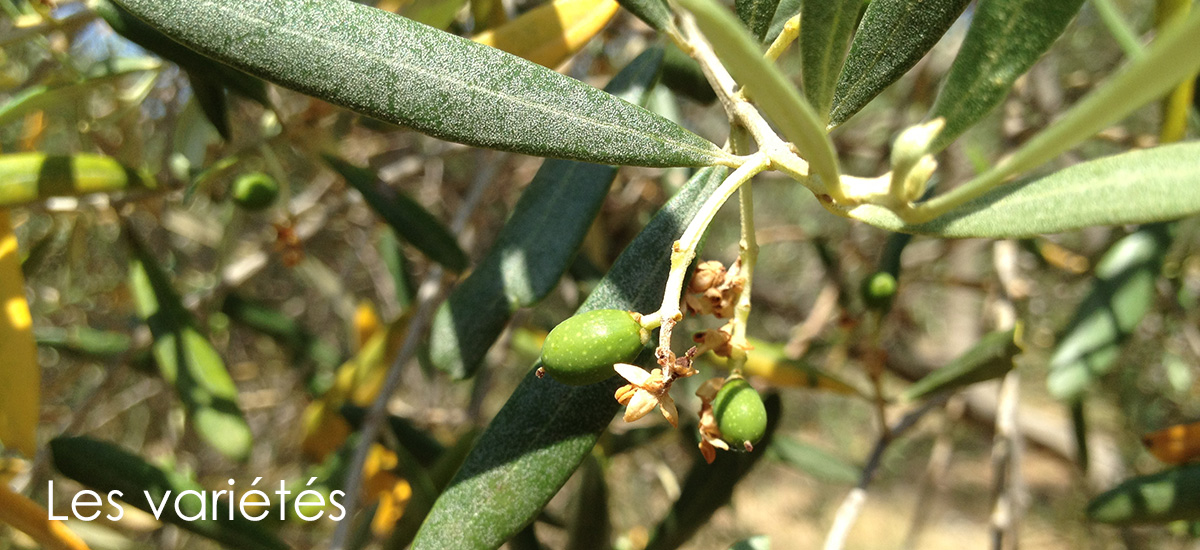
Varieties of Olives
We grow the five varieties of olives of the AOP Les Baux-de-Provence, used in both oil and table olives.
The olive variety Berruguette/ Aglandeau
- The Berruguette, also called Aglandeau, is distinguished by a tree with a denser habit than the other varieties. This olive variety is mainly intended for oil production, with yields ranging from 19 to 22%. Although it is more sensitive to drought, it stands out because of its ability to withstand the cold and wind. Its firm flesh produces a lively and full-bodied oil, with a spicy note, appreciated for its preservation properties.
- • Appearance: The Berruguette is distinguished by its elongated and curved shape, evoking a kind of crutch. This unique shape most likely contributed to its name, because “berruguette” literally means “bec de gazelle” in Provençal.
- • Colour: When ripe, Berruguette olives change colour from bright green to darker shades ranging from dark purple to black.
- • Flavour: Berruguette olives are known for their rich and fruity taste, with slightly spicy notes and moderate bitterness.
- • Use: This variety is often used to produce high quality extra virgin olive oil due to its relatively high oil content. However, Berruguette olives can also be eaten as table olives after being prepared and marinated.
- • Resistance: Berruguette olive trees are known for their resistance to harsh climatic conditions of the region, including very hot dry summers.
The variety of olive Grossane
The only variety authorized to bear the name “black olives of the Baux-de-Provence valley”, the grossane is an olive mainly grown in our department, specifically in the Alpilles. This variety requires a long time to mature, with yields between 15 and 17%. The tree prefers moisture-rich soils.
- • Appearance: Grossane olives are relatively large and round. They range in colour from dark purple to black at maturity. Their shape is rather asymmetrical and their surface can be wrinkled.
- • Flavour: One of the distinctive characteristics of Grossane olives is their slightly sweet taste. They are less bitter than some other varieties of olives, making them better for direct consumption.
- • Use: Grossane olives are often used for the production of high quality extra virgin olive oil due to their relatively high oil content. However, due to their flesh and sweet flavor, they are also eaten as table olives. They can be marinated, seasoned or simply tasted naturally.
The variety of olive Salonenque
Originally from Salon de Provence, La Salonenque is mainly grown in the Bouches-du-Rhône. The port of the tree is gracefully falling. This variety contributes to bring a distinctive smoothness to the oil it produces. Its yield is notable, ranging from 18 to 22%. Salonenque is a variety perfectly suited to calcareous, stony and shallow soils, as well as dry and windy summers.
- • Appearance: They are recognisable because of their shape reminiscent of a bumpy pear, the Salonenque has a soft green colour that evolves to purple hues at maturity. Medium to large, they are elongated and tapered in shape. When ripe, they range in colour from green to dark purple or even black.
- • Flavour: Salonenque olives are generally considered to have a mild, slightly fruity flavour. They are quite fleshy and delicate.
- • Use: Harvested when still green in September to be tasted as table olives, they are picked in October for their transformation into a sweet oil with fruity accents. Due to their flesh and moderate oil content, Salonenque olives are often used for the production of extra virgin olive oil.
- • Resistance: The tree is characterised by its sobriety and drought resistance. Salonenque olives are valued for their resistance to diseases and pests, making them a popular choice among growers.
The olive variety Verdale des Bouches-du-Rhône
Finally, the Verdale des Bouches-du-Rhône is a low-yielding olive oil. Its fragility requires pressing it immediately after harvest. This strain has built a reputation for its ability to withstand the cold. As it is also versitile, it offers green olives for the table and an oil with notes of fresh herbs and green apple. Its yield is between 14 and 15%.
- • Appearance: The Verdale des Bouches-du-Rhône is distinguished by its elongated silhouette and delicate white dots. At maturity, their color varies from green to dark purple or black.
- • Flavour: Olives of this variety are known for their fruity taste and fleshiness. They may have subtle aromas of almond and herbs.
- • Use: The Verdale des Bouches-du-Rhône are versatile and can be used both for the production of extra virgin olive oil and for the preparation of table olives.
The olive variety Picholine
The Picholine du Languedoc is not one of the typical varieties of the AOP Les Baux-de-Provence, but is cultivated for its great polinisating capacity that other varieties need to develop. A variety grown throughout the Mediterranean, they are very popular as table olives.





